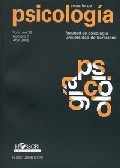Suboptimal familiar faces exposure and alectrodermal reactions
Paraules clau:
Electrodermal Reaction (EDR), Suboptimal exposure, implicit recognition.Resum
The hypothesis that the suboptimal mere exposure to familiar faces should generate greater electrodermal reactions than the same exposure to unknown faces, is formulated in this study. Such differences, in number, time, and amplitude, should be smaller when stimulus exposure is optimal. The results of two experiments, in which 60 students participated, allowed to confirm this hypothesis. Indeed, in Experiment 1, electrodemal reactions were more numerous, longer, and of greater amplitude when subjects were exposed in a suboptimal manner (50 msec) to familiar faces than to unknown faces. Those effects were also observed with optimal exposure (400 msec), but they were smaller. Experiment 2 showed that although the stimulus recognition level was 82.83% with optimal exposure, this level was only 51.74% when subjects were placed in the suboptimal exposure condition. Taken together these data lead to conclude that implicit recognition is not entirely determined by explicit recognition.Descàrregues
Publicades
1997-01-13
Número
Secció
Articles
Llicència
El/la autor/a que publica en esta revista está de acuerdo con los términos siguientes:
El/la autor/a cede en exclusiva todos los derechos de propiedad intelectual al/la editor/a para todo el mundo y toda la duración de los derechos de propiedad intelectual vigentes aplicables.
El/la autor/a puede difundir una copia de sus artículos respetando la política de acceso libre de la revista.


